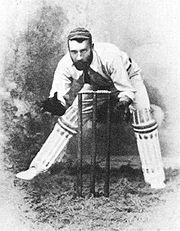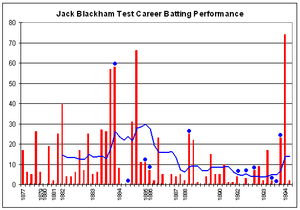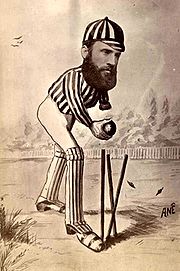
Jack Blackham
Encyclopedia
John McCarthy Blackham was a Test cricketer
who played for Victoria
and Australia
.
A specialist wicket-keeper
, Blackham played in the first Test match
at the Melbourne Cricket Ground
in March 1877 and the famous Ashes Test match
of 1882. Such was his skill in the position that he revolutionised the art of wicket-keeping and was known as the "prince of wicket-keepers". Late in his career, he captained the Australian team.
He was one of the first wicket-keepers to stand up close to the stumps, even to the fastest bowlers, wearing gloves that Jack Pollard describes as "little more than gardening gloves". He eliminated the need for a long-stop, and Pollard says that "... in England on one of his trips there a group of clergymen complained that he was a danger to the wellbeing of cricket, encouraging as he did the abolition of long-stop, the clergy's traditional fielding spot in village teams."
Blackham was selected for the very first Test match
, held at Melbourne
in March 1876/77. Australia's leading bowler Fred Spofforth
refused to play in the match, because Blackham was preferred to Spofforth's New South Wales
team-mate Billy Murdoch
. In the Test match, Blackham took three catches and made the first Test-Match stumping, when he dismissed Alfred Shaw
off the bowling of Tom Kendall
in England's second innings. In 1878, he represented his country for the first time overseas, as a member of the inaugural Australian cricket team to tour England and North America.
Described by team-mates as the "prince of wicket-keepers" and one of Australia's first cricketing heroes, "Black Jack" Blackham (nicknamed for his dark beard) was Australia's regular wicket-keeper from 1877 to 1894.
against Andrew Stoddart
's English team. As Blackham spun the coin on that opening morning, "Stoddy" remarked, "Someone will be swearing directly, Jack. I hope it's you."
 It was not: Blackham won the toss and elected to bat, and made 74 runs in a partnership of 154 with Syd Gregory
It was not: Blackham won the toss and elected to bat, and made 74 runs in a partnership of 154 with Syd Gregory
, who scored 201. This helped Australia on its way to a massive (and apparently unassailable) total of 586. Ater England followed on, Blackham's men were eventually left to make just 176 in the final innings to win. They had scored 113 for the loss of just two wickets at the close of play on the fifth evening, but it rained hard during the night.
 Blackham's veteran team-mate George Giffen
Blackham's veteran team-mate George Giffen
, however, slept right through the storm and was blissfully unaware of it when he got up the following morning, a bright and sunny one. Giffen greeted his captain cheerily at breakfast but was met with a face as "long as a coffee-pot". Blackham told him what had happened and forecast ominously the danger as the Australian team travelled to the ground, the carriage leaving deep furrows in the moist turf. Blackham was right to be so concerned: on a horrific "sticky dog", his side eventually collapsed to 166 all out, losing the match by ten runs. At the close, with the Englishmen celebrating, "Blackham walked up and down the balcony like a caged tiger, muttering 'Cruel luck - cruel luck'.... In short, the team were thoroughly cut up seeing victory thus snatched away.... 'The rain beat us,' said some of them."
"No!" retorted the Prince of Wicketkeepers. "The sun beat us" - which was probably closer to the mark.
Blackham injured himself in this match and never played Test cricket or kept wickets again.
 In his 35 Tests, which included Australia's first seventeen Tests, Blackham made 800 runs at an average of 15.68 (highest score of 74), and dismissed 60 batsmen (36 caught, 24 stumped). In 45 matches for Victoria he scored 1600 runs at 22.85, with one century (109 in 1884), and dismissed 451 batsmen. However, his value as a batsman cannot be judged by averages, as he was often at his best when the game was at a critical stage. He was not a success as a captain as he worried too much when off the field. After his retirement in 1895 a match for his benefit was arranged, and an annuity was bought with the proceeds.
In his 35 Tests, which included Australia's first seventeen Tests, Blackham made 800 runs at an average of 15.68 (highest score of 74), and dismissed 60 batsmen (36 caught, 24 stumped). In 45 matches for Victoria he scored 1600 runs at 22.85, with one century (109 in 1884), and dismissed 451 batsmen. However, his value as a batsman cannot be judged by averages, as he was often at his best when the game was at a critical stage. He was not a success as a captain as he worried too much when off the field. After his retirement in 1895 a match for his benefit was arranged, and an annuity was bought with the proceeds.
He captained Australia in eight matches, winning three. His nervous temperament meant that he worried over small setbacks, and could not bear to watch close finishes.
Blackham later invested his earnings from his tours of England, without success. A life-long bachelor, he died in Melbourne
, Victoria.
Cricketer
A cricketer is a person who plays the sport of cricket. Official and long-established cricket publications prefer the traditional word "cricketer" over the rarely used term "cricket player"....
who played for Victoria
Victorian Bushrangers
The Victorian cricket team, nicknamed the Bushrangers, is an Australian cricket team based in Melbourne, that represents the state of Victoria. It is administered by Cricket Victoria and draws its players from Melbourne's Premier Cricket competition...
and Australia
Australian cricket team
The Australian cricket team is the national cricket team of Australia. It is the joint oldest team in Test cricket, having played in the first Test match in 1877...
.
A specialist wicket-keeper
Wicket-keeper
The wicket-keeper in the sport of cricket is the player on the fielding side who stands behind the wicket or stumps being guarded by the batsman currently on strike...
, Blackham played in the first Test match
Test cricket
Test cricket is the longest form of the sport of cricket. Test matches are played between national representative teams with "Test status", as determined by the International Cricket Council , with four innings played between two teams of 11 players over a period of up to a maximum five days...
at the Melbourne Cricket Ground
Melbourne Cricket Ground
The Melbourne Cricket Ground is an Australian sports stadium located in Yarra Park, Melbourne and is home to the Melbourne Cricket Club. It is the tenth largest stadium in the world, the largest in Australia, the largest stadium for playing cricket, and holds the world record for the highest light...
in March 1877 and the famous Ashes Test match
The Ashes
The Ashes is a Test cricket series played between England and Australia. It is one of the most celebrated rivalries in international cricket and dates back to 1882. It is currently played biennially, alternately in the United Kingdom and Australia. Cricket being a summer sport, and the venues...
of 1882. Such was his skill in the position that he revolutionised the art of wicket-keeping and was known as the "prince of wicket-keepers". Late in his career, he captained the Australian team.
Early life
Blackham was born in the inner-Melbourne suburb of Fitzroy North, the son of newsagent Frederick Kane Blackham and his wife Lucinda (née McCarthy). Blackham became a bank clerk, and held a position in the Colonial Bank of Australasia for many years. It is said that his thick dark beard, perceived then as a sign of an equable and reliable nature, reassured his customers.Cricket career
Blackham was included in the first eleven of the Carlton Cricket Club as a batsman at the age of sixteen. He first appeared for the Victorian team in 1874, and remained an automatic selection as the team's wicket-keeper for over twenty years. He was a member of the first eight Australian cricket teams to visit England.He was one of the first wicket-keepers to stand up close to the stumps, even to the fastest bowlers, wearing gloves that Jack Pollard describes as "little more than gardening gloves". He eliminated the need for a long-stop, and Pollard says that "... in England on one of his trips there a group of clergymen complained that he was a danger to the wellbeing of cricket, encouraging as he did the abolition of long-stop, the clergy's traditional fielding spot in village teams."
Blackham was selected for the very first Test match
Test cricket
Test cricket is the longest form of the sport of cricket. Test matches are played between national representative teams with "Test status", as determined by the International Cricket Council , with four innings played between two teams of 11 players over a period of up to a maximum five days...
, held at Melbourne
Melbourne
Melbourne is the capital and most populous city in the state of Victoria, and the second most populous city in Australia. The Melbourne City Centre is the hub of the greater metropolitan area and the Census statistical division—of which "Melbourne" is the common name. As of June 2009, the greater...
in March 1876/77. Australia's leading bowler Fred Spofforth
Fred Spofforth
Frederick Robert "Fred" Spofforth , also known as "The Demon Bowler", was arguably the Australian cricket team's finest pace bowler of the nineteenth century and was the first bowler to take 50 Test wickets, and the first to take a test hat-trick in 1879...
refused to play in the match, because Blackham was preferred to Spofforth's New South Wales
New South Wales Blues
The New South Wales cricket team are an Australian first class cricket team based in Sydney, New South Wales...
team-mate Billy Murdoch
Billy Murdoch
William Lloyd Murdoch was an Australian cricketer, who captained the Australian team on tours to England in 1880, 1882 , 1884 and 1890...
. In the Test match, Blackham took three catches and made the first Test-Match stumping, when he dismissed Alfred Shaw
Alfred Shaw
Alfred Shaw was an eminent Victorian cricketer and rugby footballer, who bowled the first ball in Test cricket and was the first to take five wickets in a Test innings . He who organised the first British Isles rugby tour to Australasia in 1888...
off the bowling of Tom Kendall
Tom Kendall
Thomas Kingston Kendall was an Australian cricketer, who played in two Tests in 1877, including the inaugural Test which was played at the Melbourne Cricket Ground in March 1877....
in England's second innings. In 1878, he represented his country for the first time overseas, as a member of the inaugural Australian cricket team to tour England and North America.
Described by team-mates as the "prince of wicket-keepers" and one of Australia's first cricketing heroes, "Black Jack" Blackham (nicknamed for his dark beard) was Australia's regular wicket-keeper from 1877 to 1894.
His final Test
As a right-hand batsman, Blackham was a useful lower-order player. At the age of forty, he played his last Test Match at the SCGSydney Cricket Ground
The Sydney Cricket Ground is a sports stadium in Sydney in Australia. It is used for Australian football, Test cricket, One Day International cricket, some rugby league and rugby union matches and is the home ground for the New South Wales Blues cricket team and the Sydney Swans of the Australian...
against Andrew Stoddart
Andrew Stoddart
Andrew Ernest Stoddart was an English cricketer and rugby union player. He was a Wisden Cricketer of the Year in 1893.-Cricket career:...
's English team. As Blackham spun the coin on that opening morning, "Stoddy" remarked, "Someone will be swearing directly, Jack. I hope it's you."

Syd Gregory
Sydney Edward Gregory , sometimes known as Edward Sydney Gregory, was a cricketer who played for New South Wales and Australia. At the time of his retirement, he had played a world-record 58 Test matches during a career spanning 1890 to 1912...
, who scored 201. This helped Australia on its way to a massive (and apparently unassailable) total of 586. Ater England followed on, Blackham's men were eventually left to make just 176 in the final innings to win. They had scored 113 for the loss of just two wickets at the close of play on the fifth evening, but it rained hard during the night.

George Giffen
George Giffen was a cricketer who played for South Australia and Australia. An all-rounder who batted in the middle order and often opened the bowling with medium-paced off-spin, Giffen captained Australia during the 1894–95 Ashes series and was the first Australian to score 10,000 runs and...
, however, slept right through the storm and was blissfully unaware of it when he got up the following morning, a bright and sunny one. Giffen greeted his captain cheerily at breakfast but was met with a face as "long as a coffee-pot". Blackham told him what had happened and forecast ominously the danger as the Australian team travelled to the ground, the carriage leaving deep furrows in the moist turf. Blackham was right to be so concerned: on a horrific "sticky dog", his side eventually collapsed to 166 all out, losing the match by ten runs. At the close, with the Englishmen celebrating, "Blackham walked up and down the balcony like a caged tiger, muttering 'Cruel luck - cruel luck'.... In short, the team were thoroughly cut up seeing victory thus snatched away.... 'The rain beat us,' said some of them."
"No!" retorted the Prince of Wicketkeepers. "The sun beat us" - which was probably closer to the mark.
Blackham injured himself in this match and never played Test cricket or kept wickets again.
Summary

He captained Australia in eight matches, winning three. His nervous temperament meant that he worried over small setbacks, and could not bear to watch close finishes.
Blackham later invested his earnings from his tours of England, without success. A life-long bachelor, he died in Melbourne
Melbourne
Melbourne is the capital and most populous city in the state of Victoria, and the second most populous city in Australia. The Melbourne City Centre is the hub of the greater metropolitan area and the Census statistical division—of which "Melbourne" is the common name. As of June 2009, the greater...
, Victoria.

